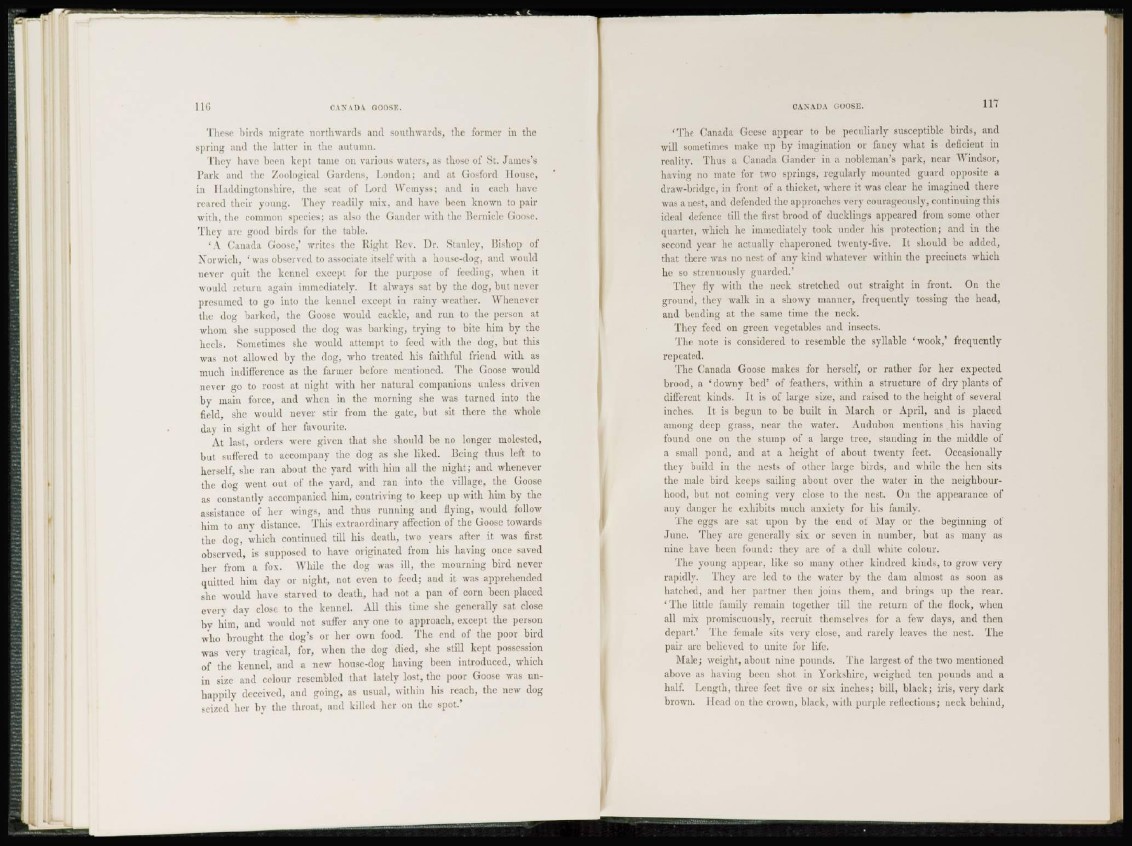
These birds migrate northwards and southwards, the former in the
spring and the latter in the autumn.
They have been kept tame on various waters, as those of St. James's
Park and the Zoological Gardens, London; and at Gosford House,
in Haddingtonshire, the scat of Lord Wemyss; and in each have
reared their young. They readily mix, and have been known to pair
with, the common species; as also the Gander with the Bemicle Goose.
They are good birds for the table.
• \ Canada Goose,' writes the Right Rev. Dr. Stanley, Bishop of
Norwich, 1 was observed to associate itself with a house-dog, and would
never quit the kennel except for the purpose of feeding, when it
would return again immediately. It always sat by the dog, but never
presumed to go into the kennel except in rainy weather. Whenever
the dog barked, the Goose would cackle, and run to the person at
whom she supposed the dog was barking, trying to bite him by the
heels. Sometimes she would attempt to feed with the dog, but this
was not allowed by the dog, who treated his faithful friend with as
much indifference as the former be tore mentioned. The Goose would
never go to roost at night with her natural companions unless driven
by main force, and when in the morning she was turned into the
field, she would never stir from the gate, but sit there the whole
day in sight of her favourite.
At hist, orders were given that she should be no longer molested,
but Buffered to accompany the dog as she liked. Being thus left to
herself, she ran about the yard with him all the night; and whenever
tin- dog went out of the yard, and ran into the village, the Goose
as constantlv accompanied him, contriving to keep up with him by the
assistance of her wings, and thus running and flying, would follow
him to any distance. This extraordinary affection of the Goose towards
the dog, which continued till his death, two years after it was first
observed, is supposed to have originated from his having once saved
her from a fox. While the dog was ill, the mourning bird never
quitted him day or night, not even to feed; and it was apprehended
she would have starved to death, had not a pan of corn been placed
evcrv day close to the kennel. All this time she generally sat close
bv him, and would not Buffer any one to approach, except the person
-who brought the dog's or her own food. The end of the poor bird
was very tragical, for, when the dog died, she still kept possession
of the kennel, and a new house-dog having been introduced, which
in size and colour resembled that lately lost, the poor Goose was unhappily
deceived, and going, as usual, within his reach, the new dog
seized her by the throat, and killed her on the spot.'
( T h e Canada Geese appear to be peculiarly susceptible birds, and
will sometimes make up by imagination or fancy what is deficient in
reality. Thus a Canada Gander in a nobleman's park, near Windsor,
having no mate for two springs, regularly mounted guard opposite a
draw-bridge, in front of a thicket, where it was clear he imagined there
was a nest, and defended the approaches very courageously, continuing this
ideal defence till the first brood of ducklings appeared from some other
quarter, which he immediately took under his protection; and in the
second year he actually chaperoned twenty-five. It should be added,
that there was no nest of any kind whatever within the precincts which
he so strenuously guarded.'
They fly with the neck stretched out straight in front. On the
ground, they walk in a showy manner, frequently tossing the head,
and bending at the same time the neck.
They feed on green vegetables and insects.
The note is considered to resemble the syllabic 'wook,' frequently
repeated.
The Canada Goose makes for herself, or rather for her expected
brood, a 'downy bed' of feathers, within a structure of dry plants of
different kinds. It is of large size, and raised to the height of several
inches. It is begun to be built in March or April, and is placed
among deep grass, near the water. Audubon mentions his having
found one on the stump of a large tree, standing in the middle of
a small pond, and at a height of about twenty feet. Occasionally
they build in the nests of other large birds, and while the hen sits
the male bird keeps sailing about over the water in the neighbourhood,
but not coming very close to the nest. On the appearance of
any danger he exhibits much anxiety for his family.
The eggs are sat upon by the end of May or the beginning of
June. They are generally six or seven in number, but as many as
nine have been found: they are of a dull white colour.
The young appear, like so many other kindred kinds, to grow very
rapidly. They are led to the water by the dam almost as soon as
hatched, and her partner then joins them, and brings up the rear.
' The little family remain together till the return of the flock, when
all mix promiscuously, recruit themselves for a few days, and then
depart.' The female sits very close, and rarely leaves the nest. The
pair are believed to unite for life.
Male; weight, about nine pounds. The largest of the two mentioned
above as having been shot in Yorkshire, weighed ten pounds and a
half. Length, three feet five or six inches; bill, black; iris, very dark
brown. Head on the crown, black, with purple reflections; neck behind,